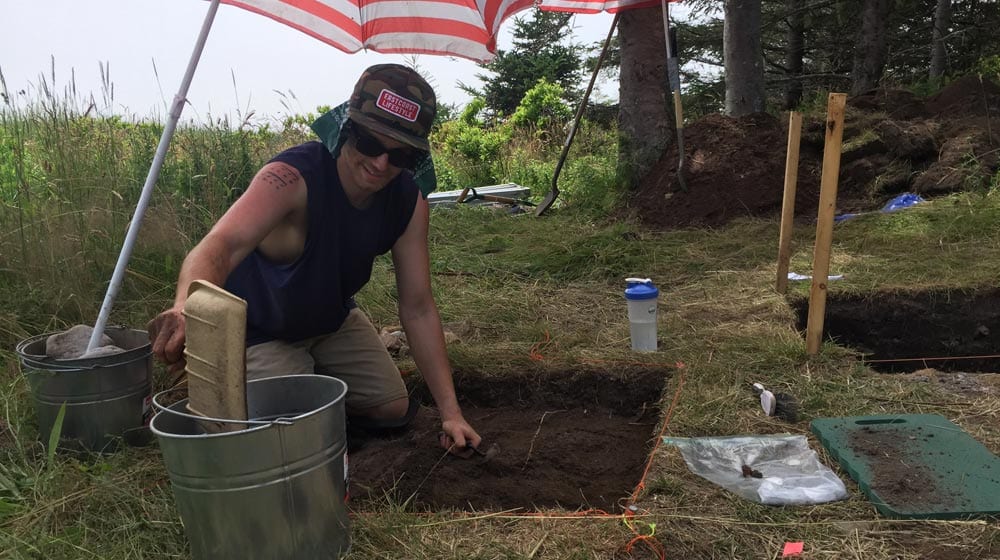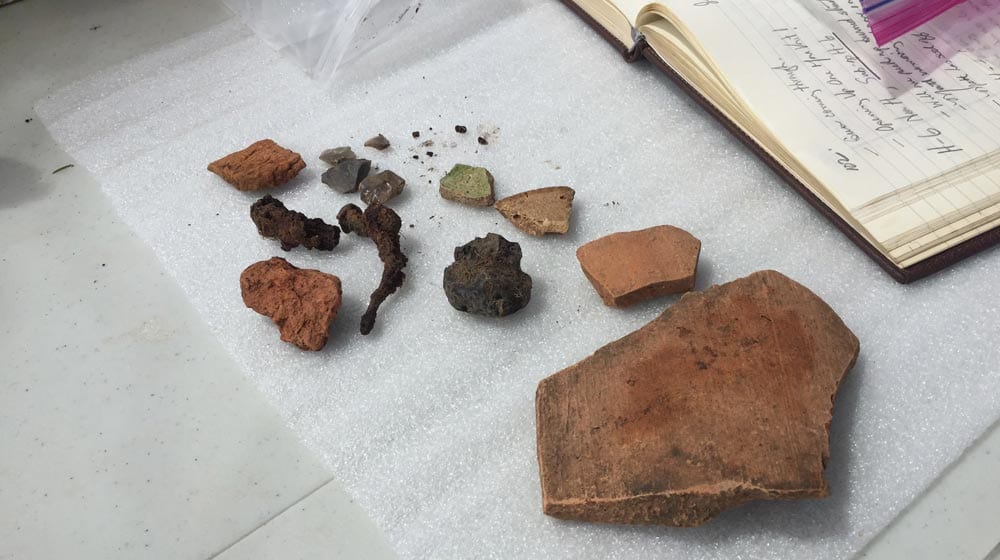The humidity in the air is thick enough to chew, and riddled with insects, as Matt Meuse-Dallien peacefully excavates a dig site off the coast of Port La Tour.
He’s one of many volunteers and employees working to unearth the past surrounding Fort Saint Louis, an early-French settlement constructed in Mi’kma’ki during the 1600’s.
Meuse-Dallien’s is from L’sitkuk First Nation and is currently employed by the Nova Scotia Museum as a geographic information systems technician (GIS) to help map the site.
“There’s a bunch of different aspects of GIS that we are going to be applying to this particular site,” Meuse-Dallien told APTN News.
“We looked at coastal erosion so we can look at some of these sites at risk. It allows us to prioritize.”
(Matt Meuse-Dallien sifts through the dirt looking for artefacts. Photo: Luke Loho/APTN)
The 26-year-old L’nu has also chosen to volunteer with the excavation during the final week of the project.
For him, this is part of a continuing journey of understanding and contributing to his Mi’kmaq heritage.
“It’s important and it’s really exciting to be a part of this type of experience,” he said. “Not a lot of Mi’kmaw people get to actually be a part of uncovering what the story actually was in certain places.”
The history of the Fort Saint Louis is being told from the Mi’kmaq perspective, rather than from a colonial viewpoint which some argue dictates the current narrative standards for history in Western society.
“I think it’s big for the Mi’kmaq people to be able to look at it (history) from that perspective, rather than just the English perspective,” adds Meuse-Dallien.
Dr Katie Cottreau-Robins, the curator of archaeology for the Nova Scotia Museum, has been actively working with Mi’kmaq and non-indigenous groups and communities to resolve this misappropriation of the area’s historical narrative.
“I think it’s essential that we approach this study from the Mi’kmaw cultural landscape perspective first,” said Cottreau-Robins, “and I think that’s going to help us interpret what’s here in a more holistic way.”
(Dr. Katie Cottreau-Robins is leading the dig at the old fort in Mi’kma’ki territory. Photo: Luke Loho/APTN)
Hidden within the landscape, fellow volunteers are discovering artefacts ranging from seed beads to Venetian shingles, which continue to help elaborate on the seldom-known history of the area during this short time period.
“We are really interested in discovering the story of the French here,” said Cottreau-Robins. “But our research focus is keeping an eye open and considering the Mi’kmaq story here first, and it’s been a good approach.”
The research project has received cooperation from both the Mi’kmaw and Acadian communities, assisting historians with filling in gaps of history lost to the wars of colonialism.
“The response to our presence here for this project has been tremendous,” said Cottreau-Robins. ”Many visitors, folks from the Acadian community volunteering, folks from the Mi’kmaq community working here, as well as many other Nova Scotians that just want to experience history in this tangible way.
Before the French constructed Fort Saint Louis, the Mi’kmaq had a very active presence hunting and fishing in the area they referred to as Kespukwitk, or “the Land Ends”.
“It’s a different approach, you know, the historical, traditional approach for colonial history has been: the French were here, the English were here and then the Mi’kmaq were here,” Cottreau-Robins said. ”And we flipped that.”
The time of the fur trade between the two cultures in the Cape Sable area is only a drop in the bucket of the millenia-old indigenous history in Mi’kma’ki but is intrinsic to explaining the dynamic relationship that stemmed between the Mi’kmaq and the French in early settlements.
The artefacts and data Cottreau-Robins’ crew collect will be studied, catalogued and preserved at the Nova Scotia Museum, where they will be stored for further study and exhibition. The project aims to return next summer, with aspirations of more volunteers eager to make their contribution to the pages of Canadian history.














Great find, one more to add to our Mi’kmaq History and being told from the Mi’kmaq Perspective, its about time.
thanks
Ellen Hunt
Great find, one more to add to our Mi’kmaq History and being told from the Mi’kmaq Perspective, its about time.
thanks
Ellen Hunt